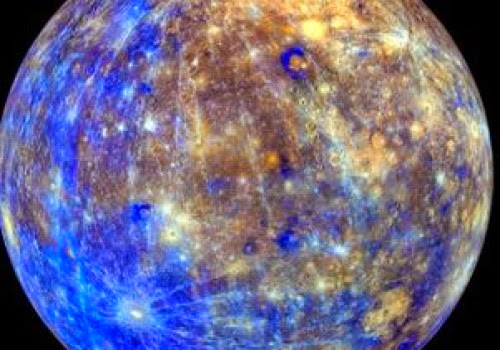
Earth and Mercury are both rocky planets with iron cores, but Mercury’s interior differs from Earth’s in a way that explains why the planet has such a bizarre magnetic field, UCLA planetary physicists and colleagues report.
Measurements from NASA’s Messenger spacecraft have revealed that Mercury’s magnetic field is approximately three times stronger at its northern hemisphere than its southern one. In the current research, scientists led by Hao Cao, a UCLA postdoctoral scholar working in the laboratory of Christopher T. Russell, created a model to show how the dynamics of Mercury’s core contribute to this unusual phenomenon.
The magnetic fields that surround and shield many planets from the sun’s energy-charged particles differ widely in strength. While Earth’s is powerful, Jupiter’s is more than 12 times stronger, and Mercury has a rather weak magnetic field. Venus likely has none at all. The magnetic fields of Earth, Jupiter and Saturn show very little difference between the planets’ two hemispheres.
Within Earth’s core, iron turns from a liquid to a solid at the inner boundary of the planet’s liquid outer core; this results in a solid inner part and liquid outer part. The solid inner core is growing, and this growth provides the energy that generates Earth’s magnetic field. Many assumed, incorrectly, that Mercury would be similar.
“Hao’s breakthrough is in understanding how Mercury is different from the Earth so we could understand Mercury’s strongly hemispherical magnetic field,” said Russell, a co-author of the research and a professor in the UCLA College’s department of Earth, planetary and space sciences. “We had figured out how the Earth works, and Mercury is another terrestrial, rocky planet with an iron core, so we thought it would work the same way. But it’s not working the same way.”
Mercury’s peculiar magnetic field provides evidence that iron turns from a liquid to a solid at the core’s outer boundary, say the scientists, whose research currently appears online in the journal Geophysical Research Letters and will be published in an upcoming print edition.
“It’s like a snow storm in which the snow formed at the top of the cloud and middle of the cloud and the bottom of the cloud too,” said Russell. “Our study of Mercury’s magnetic field indicates iron is snowing throughout this fluid that is powering Mercury’s magnetic field.”
The research implies that planets have multiple ways of generating a magnetic field.
Hao and his colleagues conducted mathematical modeling of the processes that generate Mercury’s magnetic field. In creating the model, Hao considered many factors, including how fast Mercury rotates and the chemistry and complex motion of fluid inside the planet.
The cores of both Mercury and Earth contain light elements such as sulfur, in addition to iron; the presence of these light elements keeps the cores from being completely solid and “powers the active magnetic field-generation processes,” Hao said.
Hao’s model is consistent with data from Messenger and other research on Mercury
and explains Mercury’s asymmetric magnetic field in its hemispheres. He said the first important step was to “abandon assumptions” that other scientists make.
“Planets are different from one another,” said Hao, whose research is funded by a NASA fellowship. “They all have their individual character.”
Co-authors include Jonathan Aurnou, professor of planetary science and geophysics in UCLA’s Department of Earth, Planetary and Space Sciences, and Johannes Wicht, a research scientist at Germany’s Max Planck Institute for Solar System Research.
Note : The above story is based on materials provided by University of California – Los Angeles.










